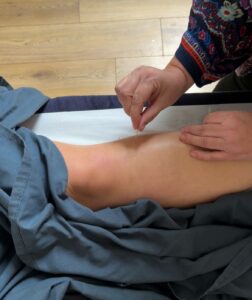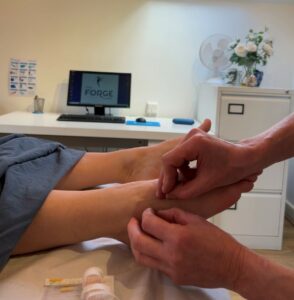At The Forge Clinic we offer both Five Element and Traditional Chinese Medicine Acupuncture Approaches and one of the most common questions we are asked is- ‘what is the difference between these types of Acupuncture?’
In recognition of Acupuncture Awareness week, we felt it would be the perfect time to delve a little deeper into these two treatment approaches, but first, a little more about Acupuncture and how it can help a range of symptoms and health concerns.
Acupuncture is an ancient medicine originating in China with the earliest records dating back over 3000 years. The treatment works by stimulating precise points along the body’s meridians, this restores the flow of qui and helps to return you to full health. Each treatment is tailored to the individual and their health concerns and needs.
Traditional Chinese Medicine and Five Elements Acupuncture have their own unique history and methods to restore balance to the body, mind, and emotions. They both, however, use the same meridians, which are the lines of energy connecting to each organ in the body, and acupuncture points. The selection and combination of these points will be slightly different and determined by the assessment and diagnosis process.
Acupuncture is commonly used to help with conditions and symptoms such as chronic pain, tension headaches and migraines, joint and muscle pain, jaw pain, side effects of chemotherapy and nausea post-surgery. Our practitioners also work with patients who are struggling with stress and anxiety, insomnia, digestive issues, menopause symptoms, fertility issues and labour induction. Both Acupuncture systems will provide effective treatment and support using a slightly different diagnostic and treatment approaches.
Traditional Chinese Medicine

Traditional Chinese Medicine (TCM) includes a combination of traditional therapies including acupuncture, herbal medicine, acupressure, moxibustion, nutrition, cupping, tui na massage and exercises (tai chi and qigong). It is one complete health system with the aim of stimulating your body, immune system, hormones, organ strength, and mind to prevent and heal disease.
TCM is based on the concept that the human body contains a set of interconnected organ systems which maintain healthy function through the balance of yin and yang, or opposing energies, and the natural flow of qi which is the body’s vital energy.
When yin (cold, cooling systems, wet, damp, mucus, phlegm, blood, hormones and water) and yang (warmth, fire, vital force, power, energy, strength, vitality) are out of balance, or there is a blockage of qi (energy) flow through the body’s energy meridians, your health may be adversely affected, and disease occurs.
TCM focuses on treating the underlying causes of the imbalance, the root of the disease whilst also managing the symptoms experienced. The aim of treatment is to bring back harmony, reverse imbalances and restore health.
Five Element Acupuncture

Five Element Acupuncture is an ancient form of acupuncture dating back to 200BC. It was introduced and taught to the west by JR Worsley. The approach focuses on the connection between mind, body, and spirit. By focusing on the spiritual and mental aspects of patient’s wellbeing, as well as their physical well-being, Five Elements Acupuncturists address the emotional side of the person to restore balance, health, and harmony. By establishing a causative factor, the acupuncturist can treat the person at the root and not just their symptoms, the aim being to stimulate the body’s healing processes.
Treatment is based around the flow of energy in the body, also known as Qi. The five elements- wood, fire, earth, metal and water each represent a connection to the Qi and the 12 organs in the body. Each organ has an energy channel which the acupuncturist will treat to restore balance to these five elements and the patient. This is achieved by stimulating precise points along the meridians and ultimately restoring the flow of Qi.
Assessment and Diagnosis
With both Five Element Acupuncture and Traditional Chinese Medicine the assessment and diagnosis will involve symptom observation, detailed medical and health information and pulses.
Traditional Chinese Medicine practitioners will take a detailed background which includes questions about how the patient is feeling, where the disease is in the body and physical and emotional symptoms. They observe the tongue colour, shapes, movements, fluids, and pulses are taken. Tongue observations and pulses are used to diagnose imbalances in the body.
Diagnosis and treatment are conducted with reference to models of the body and other principles of Traditional Chinese Medicine, and these include the five essential substances, zang fu theory (organ syndromes), the meridian system and the flow of qi. Using a variety of methods allows the practitioner to establish the roots of the disease and understand the origins of the symptoms. Based on this assessment and diagnosis the acupuncturists will prepare a specific treatment plan for your health concerns.
In Five Element Acupuncture the practitioner will ask thorough questions about the patient’s health, emotional well-being and physical symptoms. They will assess the patient’s sensory cues which include their colour, the sound of their voice and their odour, and their emotion. Lastly, they focus on the patient’s pulses, and they continue to check these throughout treatment to ensure they are balanced correctly. The assessment allows the Acupuncturist to determine the causative factor, which element the patient is, and any blockages in the organ’s energy channels. They will then prepare a treatment plan of specific acupuncture points and meridians tailored towards the patient’s element, needs, symptoms, and health concerns.
Treatments
Traditional Chinese Medicine Practitioners will prepare a tailored treatment plan which includes acupuncture points, moxa, cupping, and lifestyle advice. The therapies are used to help rebalance yin and yang by restoring the natural flow of Qi. Traditional Chinese Medicine practitioners also tailor therapies to harmonize emotions, the essence (jing) and the spirit (shen).
Good health is achieved by maintaining the body in a balanced state. Disease is a sign of an imbalance of yin and yang with disease-related imbalances sometimes being due to excess or deficiency of yin and yang. Typically, chronic illness is related to a yin dominance, whist acute illness is related to yang dominance. By emphasising a holistic approach to understanding normal function and disease processes the practitioner can focus on prevention and treatment of illness.
Five Element Acupuncture first treatment begins with acupuncture detox to draw out any energy stagnation in the body. Moxibustion is used to move qi and accumulate the energy towards the acupuncture point before it is stimulated. Unlike in Traditional Chinese Medicine, Five Element Acupuncture works on one point at a time and thus uses less needles during the treatment.
A Five Element Acupuncture Practitioner will search for energy blockages in the body’s meridians. These blocks are detected through pulse reading after each acupuncture point is stimulated. The detection of such energetic blocks is fundamental to Five Element Acupuncture and once these blocks are cleared each treatment will restore the body’s balance and equilibrium.
If you would like to understand more about the different types of Acupuncture or would like to book an appointment, please don’t hesitate to get in touch on 02083326184, or alternatively you can book online.
